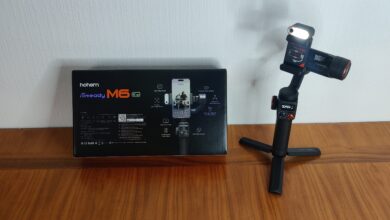
Imagine you’re on a breathtaking summit and want to capture the view in a video, but the result is blurry and out of focus. That’s where a mobile gimbal comes in. This in-depth guide takes you deep into the world of gimbals, explaining why they’re essential in smartphone videography and giving you a comprehensive overview of the best models on the market.
What is a gimbal?
A gimbal is a mechanical device that usually has three axes and is used to keep a camera or smartphone stable. The main purpose of a gimbal is to compensate for camera shake and abrupt movements to create smooth and professional moving footage. Gimbals are especially popular with filmmakers and content creators looking for stable shots and cinematic pans.
How a gimbal works
The way a gimbal works is based on the principle of gimbal suspension. This is a type of suspension that allows an object to rotate around a single axis. In a gimbal, three such suspensions are combined so that the camera can rotate around three different axes: Pitch (tilt), Yaw (pan) and Roll (roll). This means that the camera can tilt in any direction without blurring or distorting the image.
In addition to mechanical stabilization, many gimbals use built-in electronics to monitor and automatically adjust the camera’s movements. They use sensors such as gyroscopes and accelerometers to detect any movement of the gimbal. This data is then sent to a microcontroller, which instructs the gimbal’s motors to respond accordingly and keep the camera stable.
Why a gimbal is beneficial for your phone
Cell phones have come a remarkable way in recent years. The cameras built into modern smartphones can take impressive pictures and videos. But there is one area where they still lag behind professional cameras – image stabilization.
Although many phones have built-in image stabilization, it often can’t keep up with the movements that occur when filming handheld. This is where the gimbal comes in. With a gimbal, you can reduce shake and capture professional-looking video even when you’re in motion. So a gimbal can be the key to unlocking the full potential of your smartphone camera.
The leading gimbal brands and models
Of course, there are plenty of brands hawking gimbals on the market. However, in addition to numerous relatively unknown names, a handful of manufacturers have established themselves that we’d like to introduce to you:
- DJI is probably the best-known manufacturer of gimbals. The company offers a range of models that are known for their ease of use, high-quality build, and versatile features. The DJI Osmo Mobile, DJI OM 5 and DJI OM 6 are just a few examples of DJI’s diverse product line
- Hohem also offers an impressive range of gimbals. Models like the iSteady Pro 4 and iSteady V2 are known for their ruggedness and long battery life.
- Zhiyun is another brand known for its reliable and user-friendly gimbals.
Of course, there are other manufacturers that offer high-quality gimbals, such as FeiyuTech, Moza, and Glidecam. When choosing a gimbal, it is important to consider your own needs, budget and compatibility with your own camera or smartphone.
Selecting the right cell phone gimbal
The right gimbal for your phone? This can turn out to be a real challenge. There are a variety of models on the market, from affordable entry-level models to high-end professional models. Here are some factors to consider when choosing a gimbal for your phone:
- Compatibility: First, you need to make sure the gimbal is compatible with your smartphone. Some gimbals work with iOS and Android, while others are specifically designed for a particular brand or model.
- Features: Different gimbals offer different features like automatic tracking, motion timelapse, sports mode, and more.
- Weight and Size: A lightweight and compact gimbal is ideal for travel, while a larger and heavier gimbal might be more stable.
- Battery life: A longer battery is convenient when you’re on the go and don’t have a way to charge the device.
- Price/Performance: Depending on your budget, gimbals come in a variety of price ranges. However, it is worth spending a little more for a high-quality product.
Use and handling of a gimbal
When you hold your new gimbal in your hands, it might seem a little intimidating at first. But don’t worry, using a gimbal isn’t as complicated as it seems. Here are some tips for using a gimbal:
- Set up your gimbal: First, you need to set up your gimbal. This includes balancing your phone in the gimbal, downloading the associated app, and connecting the gimbal to your phone.
- Operating the Gimbal: Most gimbals have a series of buttons and joysticks that allow you to control the camera. You can pan, tilt, and roll the gimbal to get the perspective you want – just try it out.
- Using the App: Many gimbals come with a companion app that offers additional features, such as controlling camera settings, tracking faces or objects, and recording time-lapse videos.
- Care of the Gimbal: Like any electronic device, a gimbal needs care. Make sure you keep it clean and protect it from extreme temperatures and moisture.
Improve your video technique with a gimbal for mobile
A gimbal is undoubtedly an extremely powerful tool that offers tremendous support in smartphone videography. It allows you to create professional and stunning footage. However, it’s important to note that fully utilizing and maximizing gimbal capabilities requires practice, technique, and a bit of a learning curve. To get the most out of your gimbal, there are some important tips and tricks you can follow. These will help you improve your skills and achieve even more impressive results:
- Planning your shots: Before you start filming, you should have an idea of what you want to film. Planning will help you go through smooth transitions and interesting camera movements.
- Practice makes perfect: It takes time to get a feel for operating a gimbal. So practice as often as possible to improve your technique. Learn to balance your gimbal, because a properly balanced gimbal will give you the best results.
- Experiment with settings: Use the different modes and functions of your gimbal to make different types of shots.
- Keep your gimbal clean and safe: Clean your gimbal regularly and store it in a secure bag when not in use.
Your gimbal and your phone camera: the perfect duo
A gimbal is only as good as the camera attached to it. Therefore, you should make sure your smartphone has a good camera before investing in an expensive gimbal. Most modern smartphones have excellent cameras that can deliver amazing results when combined with a gimbal.
Most gimbals also have their own apps that you can download to use advanced shooting features. These apps can control your phone’s camera settings and allow you to take photos and record video from your gimbal.
How important is app compatibility? – Gimbal for mobile
The compatibility of the gimbal with the app is crucial. Almost all gimbals come with an associated app that needs to be installed on your smartphone in order to use the full functionality of the gimbal. The app allows you to control the gimbal, adjust its settings, and use some additional features, such as tracking faces or objects, creating time-lapse or panoramic shots, and more. Therefore, it is important to make sure that your gimbal’s app is compatible with your smartphone.
Advanced features and apps for your mobile gimbal
Some of the advanced features you can expect from a gimbal include:
- Stabilization: This is the main function of a gimbal and helps minimize camera shake.
- Tracking: Many gimbals have a tracking feature that allows you to keep a specific object or person in focus, even if they are moving.
- Panorama: Some gimbals have a panorama feature that allows you to take wide or even 360-degree shots.
- Time-lapse: This feature allows you to capture stunning time-lapse videos.
Apps like DJI Mimo and Filmic Pro can help you get the most out of your gimbal. They offer different shooting modes, advanced setting options, and even editing tools to edit your videos right on your phone.
Are there alternatives to gimbals for cell phones?
Yes, there are alternatives to a cell phone gimbal, although they may not offer the same stabilization performance. Some alternatives are:
- Steadycams: Steadycams or stabilizers are devices that compensate for shake and abrupt movements similar to gimbals. They can be a good alternative for gimbals, but require more practice and skill to use.
- Tripod: A tripod can be a good option if you’re shooting mostly still and don’t need movement.
- Selfie Stick: For simple shots and selfies, a selfie stick may be sufficient, although it doesn’t provide the same stabilization as a gimbal.
- Hand stabilization: With a little practice, you can learn to stabilize your phone by hand, holding it firmly and steady. However, this is nowhere near as effective as using a gimbal.
Are there phones with built-in gimbal function?
In fact, there are smartphones that have a built-in gimbal function. One example of this is the Vivo X60 Pro Plus. In this device, the main camera is mounted on a gimbal that compensates for movements in all directions and thus enables excellent image stabilization. The successor model Vivo X90 Pro unfortunately does without the feature. However, such phones are still rather the exception and often cannot keep up with a proper gimbal in terms of stabilization and features.
With this information, you are now well prepared to dive into the world of gimbal phone videography. Whether you’re an avid hobbyist or a budding professional videographer, a gimbal can definitely make a big difference in your video quality.




No replies yet
Neue Antworten laden...
Gehört zum Inventar
Beteilige dich an der Diskussion in der Basic Tutorials Community →